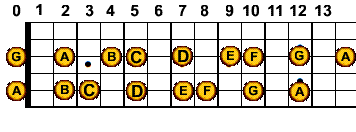How To Learn The Names Of The Notes On The Neck Of The Guitar
First of all, why should you bother to learn all of the guitar notes at every fret of the guitar neck? I know it can be boring and you can get by without doing it but the fact is, you will become a much better player if you learn how to play the right way. You need to learn them even if you aren't serious about playing guitar. It helps construct yourself as a better player and it will help you with improvisation.Should you learn guitar scales, guitar chords, or guitar notes first? Most people will say learn your basic chords first, then learn your scales, and notes last. Occasionally you will hear that if you want to understand why the chords work like they do then learn notes. Ideally, you will be doing all three at the same time.
What I'm not going to be doing is teaching you how to read music or guitar tabs. I'm not going to discuss basic chord theory either, that's for another lesson. Guitar licks and solos will be left for another lesson as well but will be much easier once you've completed this one. All I'm going to do in this article is to show you a simple method of finding the notes on your guitar.
The first thing to do is memorise the notes on the sixth, or low e-string, and fifth, A, strings. These two strings are important to learn because they will be the root notes for many chords you play (see: Learn How To Play Guitar Chords).
The neck diagram below shows the notes on the sixth string except for the sharps and flats. Notice that the notes repeat after the twelfth fret. Fret thirteen is the same note as fret one but an octave higher:
 |
| Sixth String Notes |
The next diagram shows the notes on the fifth
string of the guitar fretboard:
 |
| Fifth String Notes |
From here it gets easier, no more remembering
notes. The next diagram shows the relationship between the notes on the sixth
and fourth strings. Notice that a note on the sixth string is repeated an octave
higher two frets up on the fourth string. This is the distance between the first
and third fingers without stretching:
 |
| Notes On The Sixth And Fourth Strings |
The next diagram shows the relationship
between the notes on the fifth and third strings and is similar to the previous
one. You should now realise that by learning the notes on two strings you can
easily work out the notes on two other strings:
 |
| Notes On The Fifth And Third Strings |
If we now add the second string to the diagram
of the fourth and sixth strings, we see the relationship is slightly different.
Instead of being two frets between the same notes on the second and fourth
strings, there are now three. That's the distance between the first finger and
little finger without stretching:
 |
| Notes On The Sixth, Fourth, And Second Strings |
The last of the neck diagrams shows the sixth
string and first string, or high e-string. This is the easiest of all, they are
both identical.
 |
| Notes On The Sixth And First Strings |
No comments:
Post a Comment